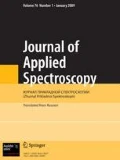A regression approach is proposed for planning aerosol optical experiments and for estimating the potential accuracy of the derived microphysical parameters of atmospheric aerosols taking the features of the apparatus and the available a priori information into account. This method is used to evaluate the informativity of polarization spectronephelometer measurements with respect to the microphysical parameters of continental aerosols. The problem of choosing the most informative aerosol optical characteristics with respect to the mass concentrations of the PM 2.5 and PM 10 respirable fractions is examined and regression equations are derived for determining these concentrations from lidar probe data at wavelengths of 0.355 and 1.064 μm, as well as from reference measurements at 0.37 and 0.98 μm. The theoretical results obtained here are compared with AERONET data.
Similar content being viewed by others
References
M. M. Kugeiko and S. A. Lisenko, Zh. Prikl. Spektrosk., 73, 807–812 (2006).
M. M. Kugeiko and S. A. Lisenko, Opt. Spektrosk., 107, No. 1, 165–172 (2009).
V. A. Korshunov, Opt. Atm. Okeana, 43, 671–687 (2007).
V. A. Kolemaev and V. N. Kalinina, Probability Theory and Mathematical Statistics [in Russian], INFRA-M, Moscow (1997).
M. I. Mishcenko, L. D. Travis, and A. A. Lacis. Scattering, Absorption, and Emission of Light by Small Particles, NASA Goddard Institute for Space Studies, New York (2004).
M. I. Mishcenko, L. D. Travis, R. A. Kahn, R. A. West. J. Geophys. Res., 102, 16831–16847 (1997).
K. Ya. Kondrat’ev, L. S. Ivlev, and V. F. Krapivin, Properties, formation processes and interaction consequences of atmospheric aerosols [in Russian], S.-Pb. gos. un-t., St. Petersburg (2007).
C. Cattrall, J. Reagan, K. Thome, and O. Dubovic. J. Geophys. Res. 110, D10S11 (2005). doi: 10.1029/2004JD005124.
ttp://aeronet. gsfc. nasa. gov
M. A. Sviridenkov, A. S. Emilenko, A. A. Isakov, and V. M. Kopeikin, Proc. Fifteenth ARM Sci. Team Meeting, Daytona Beach, Florida, March 14–18 2005, Am. Assoc. Aerosol Res. (2005).
M. V. Panchenko, M. A. Sviridenkov, S. A. Terpugova, and V. S. Kozlov, Opt. Atm. Okeana, 17, 428–435 (2004).
U. S. EPA Guidance for Using Continuous Monitors in PM2.5 Monitoring Networks, OAQPS EPA-454/R-98-012, Environmental Protection Agency, Chicago (1998).
European Standard EN 12341. Air Quality. Determination of the PM10 Fraction of Suspended Particulate Matter. Reference Method and Field Test Procedure to Demonstrate Reference Equivalence of Measurement Methods (1998).
V. P. Ivanov, Applied Atmospheric Optics in Thermal Vision [in Russian], Novoe Znanie, Kazan (2000).
Author information
Authors and Affiliations
Corresponding author
Additional information
Translated from Zhurnal Prikladnoi Spektroskopii, Vol. 76, No. 6, pp. 876–883, November–December, 2009.
Rights and permissions
About this article
Cite this article
Lisenko, S.A., Kugeiko, M.M. Regression approach to analyzing the informativity and interpretation of aerosol optical measurements. J Appl Spectrosc 76, 826–832 (2009). https://doi.org/10.1007/s10812-010-9278-8
Received:
Published:
Issue Date:
DOI: https://doi.org/10.1007/s10812-010-9278-8



